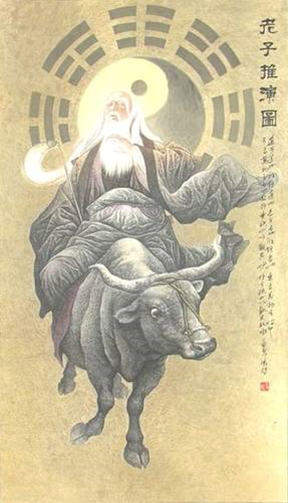Laozi 老子 – Legend or History?
A brief biography of the author of the Dao De Jing
By Christina J Barea
Many people are familiar with the Dao De Jing 道德經, a classic of Daoist studies, which is a compilation of 5,000 characters divided into 81 chapters which includes instructions on living life in balance and harmony. The Dao De Jing (Scripture on Virtue and The Way) is commonly attributed to Laozi (Old Teacher) as author. Although some scholars are now suggesting that the Dao De Jing is actually a collection of works from various sources, all agree that the Dao De Jing is an ancient literary work dated at approximately 500 BCE. A
Laozi himself is the subject of several legends contributing to the ambiguity of his life and the actual origin of the Dao De Jing. In summary, these legends say that Laozi was a mortal man who, following the teachings of the Dao, gave up his worldly connections to live a simple life communing with nature. Before he left and eventually ascended to the 9 levels of Heaven, Laozi recorded the Dao De Jing, leaving a valuable resource which thrives to this day.
Laozi’s Symbolic Mortal Life
One version regarding the origin of Laozi’s life is mythical. In this account, Lao Tzu, whose name at that time was Li Erh, is born of his mother after 62 years of gestation. He is birthed as a grown man of 80 years with white hair and long ears, both symbols of wisdom. According to Chinese symbolism and mythology, both the numbers used to mark his gestation and birth age, along with the physical traits of his being, would all be a poetic emphasis on the wisdom he embodies. 8 is a magical number considered good luck by Daoists.
Laozi’s Probable Chronology
Another version is that at the age of 80, Laozi retired from years of service in the libraries of Zhou city to a remote region in Western China, far away from the pressures and obligations of village life. Meeting the Guard Yin Xi upon exiting the city, he was asked to impart some final wisdom. Laozi gifted the guard with a 5,000 character scroll containing the Dao De Jing and then disappeared into the mountains never to be seen again.
Laozi- Half Human, Half Immortal
Daoist priests share one final version where nestled in the remote mountains of Western China, Laozi’s faithful meditations and spiritual practice were rewarded with the transmission of the Dao De Jing by the immortal version of himself. Having recorded this precious work, Laozi ascended the highest level of Heaven on a black ox. This version emphasizes the Daoist belief that a person can have an immortal soul (shen xian), a version of the self that persists through many lifetimes; while at the same time possessing a spirit (yuan shen), translatable to that part of the self, attributed to the combination of both the time/place of birth and the energies of mother and father.
In all versions, Laozi now resides in the highest levels of the Daoist Pantheon. He is one of the “San Qing”- Three Pure Ones and continues to exert his influence on all beings to this day. The many altars and places of worship of “Tai Shang Lao Jun” (his respected immortal name) around China visually demonstrate how important the Dao De Jing is even after 2500 years. And, the legends regarding his teachings continue to evolve.
Christina Barea-Young is a Daoist Priest of the Zheng Yi Pai (China) and a Medical Qigong Therapist. She dedicates her time to helping people find balance through Medical Qigong Therapy, Qigong & Tai Chi instruction and TCM related talks, workshops and courses. She is a member of the National Qigong Association and currently serves on the Board of Directors. Christina has just completed 2 books, the first a translation of Daoist Scripture and the second on qigong exercises. For more information about her please visit:http://www.therisinglotus.com/



